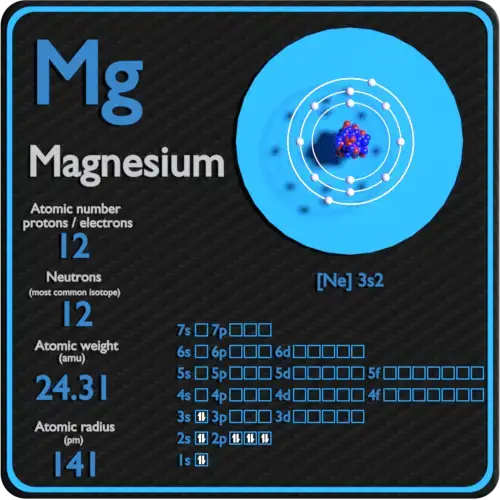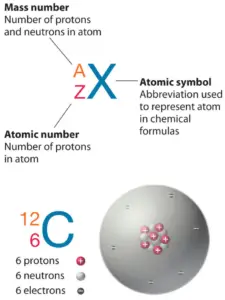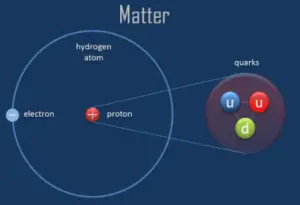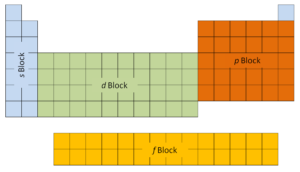
Magnesium is a shiny grayness solid which bears a close physical resemblance to the other v elements in the second column (group 2, or alkaline world metals) of the periodic tabular array: all group two elements have the same electron configuration in the outer electron shell and a similar crystal construction.
Magnesium is the third-most-commonly-used structural metal, following iron and aluminium. The chief applications of magnesium are, in order: aluminium alloys, dice-casting (alloyed with zinc), removing sulfur in the product of iron and steel, and the production of titanium in the Kroll procedure. Magnesium is today obtained mainly by electrolysis of magnesium salts obtained from brine.
Protons and Neutrons in Magnesium
 Magnesium is a element with atomic number12 which means there are 12 protons in its nucleus. Full number of protons in the nucleus is chosen thediminutive number of the atom and is given thesymbol Z. The total electrical charge of the nucleus is therefore +Ze, where e (elementary charge) equals to1,602 ten 10-19 coulombs.
Magnesium is a element with atomic number12 which means there are 12 protons in its nucleus. Full number of protons in the nucleus is chosen thediminutive number of the atom and is given thesymbol Z. The total electrical charge of the nucleus is therefore +Ze, where e (elementary charge) equals to1,602 ten 10-19 coulombs.
The full number of neutrons in the nucleus of an atom is called theneutron number of the atom and is given thesymbol Northward. Neutron number plus atomic number equals atomic mass number:Due north+Z=A. The difference betwixt the neutron number and the atomic number is known as theneutron excess: D = N – Z = A – 2Z.
For stable elements, at that place is usually a variety of stable isotopes. Isotopes are nuclides that take the same atomic number and are therefore the same element, but differ in the number of neutrons. Mass numbers of typical isotopes of Magnesium are24; 25 ;26.
Main Isotopes of Magnesium
Magnesium naturally occurs in three stable isotopes, 24Mg, 25Mg, and 26Mg. The longest-lived radioisotope is 28Mg with a half-life of twenty.915 hours. The lighter isotopes mostly decay to isotopes of sodium while the heavier isotopes decay to isotopes of aluminium.
Magnesium-24 is composed of 12 protons, 12 neutrons, and 12 electrons.
Magnesium-25 is composed of 12 protons, xiii neutrons, and 12 electrons.
Magnesium-26 is composed of 12 protons, 12 neutrons, and 12 electrons.
Electrons and Electron Configuration
The number of electrons in an electrically-neutral atom is the same equally the number of protons in the nucleus. Therefore, the number of electrons in neutral atom of Magnesium is 12. Each electron is influenced by the electric fields produced by the positive nuclear charge and the other (Z – 1) negative electrons in the atom.
Since the number of electrons and their arrangement are responsible for the chemical beliefs of atoms, theatomic number identifies the diverse chemical elements. The configuration of these electrons follows from the principles of quantum mechanics. The number of electrons in each element'south electron shells, particularly the outermost valence shell, is the principal cistron in determining its chemical bonding behavior. In the periodic table, the elements are listed in social club of increasing diminutive number Z.
Electron configuration ofMagnesiumis[Ne] 3s2.
Possible oxidation states are+2.
Magnesium occurs naturally only in combination with other elements, where it invariably has a +2 oxidation country. The free element (metallic) tin can exist produced artificially, and is highly reactive (though in the temper, it is soon coated in a sparse layer of oxide that partly inhibits reactivity). The free metallic burns with a feature brilliant-white light.
Typical Alloy of Magnesium
In general,Elektron is the registered trademark of a wide range of magnesium alloys manufactured by a British company Magnesium Elektron Limited.Elektron 21, designated by UNS M12310, is ane of alloys with excellent corrosion resistance and castability. Cast products possess a fine-grained microstructure and pressure tightness. This alloy tin exist easily machined. Application include motorsports and aerospace, since it possess high strength, lite weight and it has excellent vibration damping characteristics.
About Protons
 A proton is ane of the subatomic particles that brand up matter. In the universe, protons are abundant, making upwell-nigh half of all visible matter. Information technology hasa positive electric charge (+1e) and a rest mass equal to 1.67262 × 10−27 kg (938.272 MeV/c 2 )— marginally lighter than that of the neutron but about 1836 times greater than that of the electron. The proton has a mean square radius of about 0.87 × ten−xv m, or 0.87 fm, and information technology is a spin – ½ fermion.
A proton is ane of the subatomic particles that brand up matter. In the universe, protons are abundant, making upwell-nigh half of all visible matter. Information technology hasa positive electric charge (+1e) and a rest mass equal to 1.67262 × 10−27 kg (938.272 MeV/c 2 )— marginally lighter than that of the neutron but about 1836 times greater than that of the electron. The proton has a mean square radius of about 0.87 × ten−xv m, or 0.87 fm, and information technology is a spin – ½ fermion.
The protons be in the nuclei of typical atoms, forth with their neutral counterparts, the neutrons. Neutrons and protons, commonly chosennucleons, are spring together in the atomic nucleus, where they account for 99.9 percentage of the atom'south mass. Research in loftier-energy particle physics in the 20th century revealed that neither the neutron nor the protonis not the smallest building block of matter.
About Neutrons
A neutron is one of the subatomic particles that make up matter. In the universe, neutrons are abundant, making upmore than than half of all visible matter. It hasno electric accuse and a remainder mass equal to 1.67493 × 10−27 kg—marginally greater than that of the proton but about 1839 times greater than that of the electron. The neutron has a mean square radius of about 0.8×10−15 1000, or 0.viii fm, and it is a spin-½ fermion.
Atomic nuclei consist of protons and neutrons, which attract each other throughthe nuclear force, while protons repel each other viathe electric force due to their positive charge. These two forces compete, leading to various stability of nuclei. At that place are only sure combinations of neutrons and protons, which formsstable nuclei.
Neutrons stabilize the nucleus, because they attract each other and protons , which helps offset the electrical repulsion between protons. Equally a result, as the number of protons increases,an increasing ratio of neutrons to protons is needed to class a stable nucleus. If at that place are too many or too few neutrons for a given number of protons, the resulting nucleus is not stable and it undergoes radioactive decay.Unstable isotopesdisuse through various radioactivity pathways, almost commonly alpha disuse, beta decay, or electron capture. Many other rare types of disuse, such as spontaneous fission or neutron emission are known. It should be noted that all of these disuse pathways may be accompanied bythe subsequent emission of gamma radiations. Pure alpha or beta decays are very rare.
About Electrons and Electron Configuration
The periodic table is a tabular display of the chemical elements organized on the basis of their atomic numbers, electron configurations, and chemical properties. The electron configuration is the distribution of electrons of an atom or molecule (or other physical construction) in atomic or molecular orbitals. Knowledge of theelectron configuration of different atoms is useful in understanding the structure of the periodic table of elements.
Every solid, liquid, gas, and plasma is equanimous of neutral or ionized atoms. Thechemic properties of the cantlet are determined by the number of protons, in fact, by number andarrangement of electrons. Theconfiguration of these electrons follows from the principles of breakthrough mechanics. The number of electrons in each element's electron shells, peculiarly the outermost valence beat out, is the primary gene in determining its chemic bonding behavior. In the periodic table, the elements are listed in guild of increasing atomic number Z.
It is thePauli exclusion principle that requires the electrons in an cantlet to occupy unlike free energy levels instead of them all condensing in the ground state. The ordering of the electrons in the ground state of multielectron atoms, starts with the lowest energy land (ground country) and moves progressively from there upward the energy calibration until each of the atom's electrons has been assigned a unique prepare of quantum numbers. This fact has key implications for the building upwards of the periodic table of elements.
 The beginning two columns on the left side of the periodic table are where thes subshells are beingness occupied. Because of this, the beginning ii rows of the periodic table are labeled thes block. Similarly, thep blockare the right-most half-dozen columns of the periodic tabular array, thed blockis the middle 10 columns of the periodic table, while thef blockis the 14-cavalcade section that is normally depicted as detached from the main body of the periodic table. It could be part of the principal body, merely so the periodic table would be rather long and cumbersome.
The beginning two columns on the left side of the periodic table are where thes subshells are beingness occupied. Because of this, the beginning ii rows of the periodic table are labeled thes block. Similarly, thep blockare the right-most half-dozen columns of the periodic tabular array, thed blockis the middle 10 columns of the periodic table, while thef blockis the 14-cavalcade section that is normally depicted as detached from the main body of the periodic table. It could be part of the principal body, merely so the periodic table would be rather long and cumbersome.
For atoms with many electrons, this notation can get lengthy and then an abbreviated notation is used. The electron configuration can be visualized as the core electrons, equivalent to theelement of group 0 of the preceding period, and the valence electrons (eastward.yard. [Xe] 6s2 for barium).
Oxidation States
Oxidation states are typically represented by integers which may exist positive, naught, or negative. Near elements have more than one possible oxidation state. For example, carbon has nine possible integer oxidation states from −4 to +4.
The current IUPAC Gold Book definition of oxidation state is:
"Oxidation state of an atom is the charge of this atom afterwards ionic approximation of its heteronuclear bonds…"
and the term oxidation number is nearly synonymous. An element that is not combined with whatever other dissimilar elements has an oxidation country of 0. Oxidation land 0 occurs for all elements – it is just the chemical element in its elemental form. An atom of an element in a chemical compound will have a positive oxidation state if it has had electrons removed. Similarly, calculation electrons results in a negative oxidation state. We have also distinguish between the possible and mutual oxidation states of every element. For case, silicon has nine possible integer oxidation states from −four to +4, but merely -four, 0 and +4 are common oxidation states.
Summary
| Element | Magnesium |
| Number of protons | 12 |
| Number of neutrons (typical isotopes) | 24; 25 ;26 |
| Number of electrons | 12 |
| Electron configuration | [Ne] 3s2 |
| Oxidation states | +2 |

Source: www.luciteria.com
Other properties of Magnesium

 Magnesium is a element with atomic number12 which means there are 12 protons in its nucleus. Full number of protons in the nucleus is chosen thediminutive number of the atom and is given thesymbol Z. The total electrical charge of the nucleus is therefore +Ze, where e (elementary charge) equals to1,602 ten 10-19 coulombs.
Magnesium is a element with atomic number12 which means there are 12 protons in its nucleus. Full number of protons in the nucleus is chosen thediminutive number of the atom and is given thesymbol Z. The total electrical charge of the nucleus is therefore +Ze, where e (elementary charge) equals to1,602 ten 10-19 coulombs.

 A proton is ane of the subatomic particles that brand up matter. In the universe, protons are abundant, making upwell-nigh half of all visible matter. Information technology hasa positive electric charge (+1e) and a rest mass equal to 1.67262 × 10−27 kg (938.272 MeV/c 2 )— marginally lighter than that of the neutron but about 1836 times greater than that of the electron. The proton has a mean square radius of about 0.87 × ten−xv m, or 0.87 fm, and information technology is a spin – ½ fermion.
A proton is ane of the subatomic particles that brand up matter. In the universe, protons are abundant, making upwell-nigh half of all visible matter. Information technology hasa positive electric charge (+1e) and a rest mass equal to 1.67262 × 10−27 kg (938.272 MeV/c 2 )— marginally lighter than that of the neutron but about 1836 times greater than that of the electron. The proton has a mean square radius of about 0.87 × ten−xv m, or 0.87 fm, and information technology is a spin – ½ fermion. The beginning two columns on the left side of the periodic table are where thes subshells are beingness occupied. Because of this, the beginning ii rows of the periodic table are labeled thes block. Similarly, thep blockare the right-most half-dozen columns of the periodic tabular array, thed blockis the middle 10 columns of the periodic table, while thef blockis the 14-cavalcade section that is normally depicted as detached from the main body of the periodic table. It could be part of the principal body, merely so the periodic table would be rather long and cumbersome.
The beginning two columns on the left side of the periodic table are where thes subshells are beingness occupied. Because of this, the beginning ii rows of the periodic table are labeled thes block. Similarly, thep blockare the right-most half-dozen columns of the periodic tabular array, thed blockis the middle 10 columns of the periodic table, while thef blockis the 14-cavalcade section that is normally depicted as detached from the main body of the periodic table. It could be part of the principal body, merely so the periodic table would be rather long and cumbersome.
0 Response to "Magnesium Protons Neutrons And Electrons"
Post a Comment